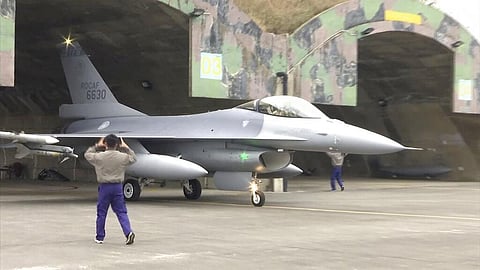

TAIPEI: Hours after Chinese aircraft carrier Shandong sailed through the Taiwan Strait, two Shenyang J-11 fighter jets and a Harbin Z-9 anti-submarine helicopter entered Taiwan's air defense identification zone (ADIZ) on Friday.
The Ministry of National Defense informed that Taiwan's Air Force jets issued radio warnings telling the Chinese aircraft to turn back immediately, reported Taiwan News.
The military also said it deployed air defense missile systems to monitor the activities of the People's Liberation Army Air Force jets and helicopter.
The aircraft was spotted during the day in the southwest sector of the ADIZ off the coast of Taiwan's main island, the Liberty Times reported.
Because there was no land close to the area where the helicopter appeared, speculation was that it had taken off from a Chinese navy vessel, reported Taiwan News.
China's Shandong carrier earlier sailed past the island of Kinmen before heading north through the Taiwan Strait.
The United States guided-missile destroyer USS Ralph Johnson was shadowing the Chinese ship, while vessels from Taiwan's Navy were also present in the area, according to the report.
Washington's efforts to pressurize China into opening up the tightly guarded region have not succeeded as a new US Congress report assessment indicated that foreign diplomats, journalists and tourists were "systematically" denied access to China's Tibet autonomous region over the past year.
The dire assessment comes despite attempts by Washington to force Beijing to relax the limits it has long imposed on Tibet, including by sanctioning Chinese officials involved in formulating or enacting those restrictions, reported Policy Research Group (POREG)
Compounded by the coronavirus pandemic and China's closure of the US embassy in neighbouring Sichuan province, there was no sign of a loosening of restrictions compared with 2020, the State Department said in an annual report to Congress published on Thursday.
The obstacles, the report alleged, included harassment of US journalists, the stonewalling of diplomats' engagements with locals in Tibetan areas outside Tibet, and the refusal by the Chinese government to greenlight any visits to Tibet by the US charge d'affaires at its Beijing embassy.
"(China's) security forces used conspicuous monitoring to intimidate US diplomats and officials including while on personal travel to Tibetan areas, followed them, prevented them from meeting or speaking with local contacts, harassed them, and restricted their movement in these areas," the report said.
The report also noted that US efforts to access Tibet had been "severely" constrained by China's closure of Washington's consulate in Sichuan's Chengdu in July 2020 - in retaliation for the US government's closure of a Chinese consulate in Houston over accusations of espionage, reported POREG.
The report also said that rejections of tourists' applications to visit had increased around politically sensitive times, including the March anniversary of the 1959 uprising in Tibet against Chinese rule and the Dalai Lama's birthday in July.
Despite the remote and sparsely populated western region experiencing low infection rates during the pandemic, authorities in Tibet and surrounding provinces implemented "heavily" restrictive travel limits that had stayed in place for much of the past year, according to the report.
The restrictions, alleged the State Department, had been used by Chinese authorities as a "pretext" for detaining, harassing or removing US journalists from reporting in regions near Tibet, reported POREG.
The State Department report comes weeks after Freedom House, a US-based international democracy watchdog, ranked Tibet as the least free territory in the world - alongside Syria and South Sudan - for the second year in a row.